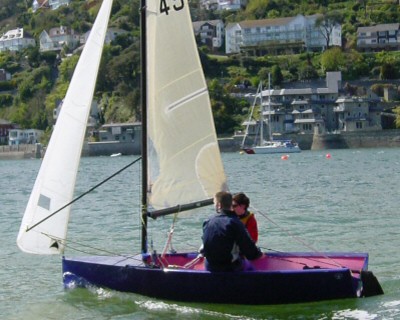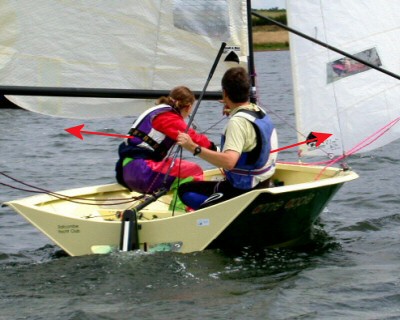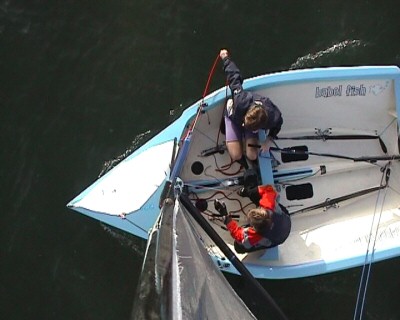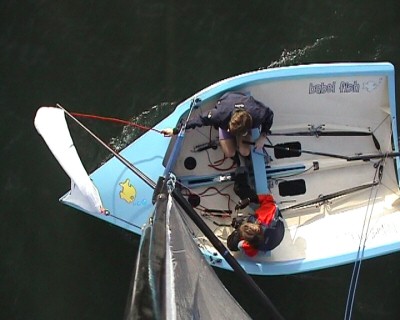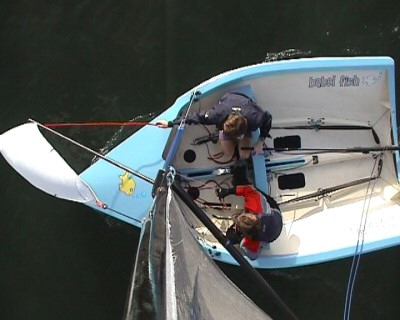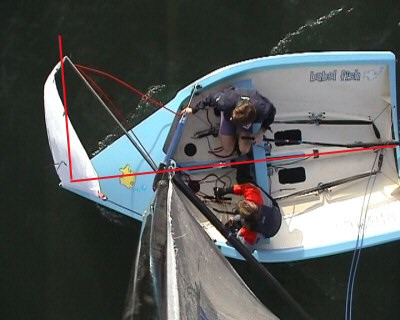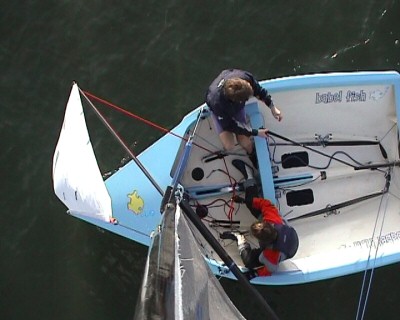Topic: Running
|
Sailing downwind is an exercise in balance and co-ordination. The golden rules are:
To check if the trim is right look at the water flowing past the transom. If it is turbulent you should sit further forwards. If you are a heavy weight team you may have to compromise and drag the transom a little to avoid burying the nose excessively. Crew positioning When running it is very important that the helm is able to sit on the deck. This enables them to look around for gusts and it is easier for the helm to make fine steering adjustments. This picture shows the helm in an awkward position. Notice the tiller and tiller extension are in line which reduces the helm's control. The crew needs to sit further to leeward and push the boom out at the same time. Windward heel gets you more speed A small amount of windward heel is good in light to medium conditions. It gets the boom higher off the water into the stronger wind and also lightens the load on the rudder. The boom should be pushed out as far as possible and the leeward shroud released to help it go further. The kicker should be eased so the top batten isn't hooked and in light winds the batten should twist forwards of the boom so it is at 90o to the wind. But too much windward heel . . . can be dangerous! In windy weather it is generally best to keep the boat flat. "Death rolls" in 12s are common when the rudder loads up and stalls. You can avoid this by:
Setting the dangly pole - step 1 The dangly pole is great on the run and should be used whenever possible. It allows you to goosewing the jib quickly without the crew having to go forwards. Setting the pole requires co-ordinating the jib sheet and the dangly pole string. One way to do this is for the helm to pull the jib to windward using the jib sheet while the crew pushes the pole out. This manoeuvre takes practice to get the timing right. Step 2 - pushing out the pole The helm has pulled the jib to windward and the crew is starting to push the pole out on the windward side. The helm pays out the jib sheet as the pole goes out. Step 3 - keep on pushing The helm continues to pay out the jib sheet until the pole is at full extension. Step 4 - Trimming the pole Once the pole is fully out the crew takes the windward sheet from the helm and trims the jib. On a dead run you should be looking for the jib to be perpendicular to the boat. On the shore you should check that your pole is rigged so it can do this.
Step 5 - keep on trimming Helm and crew move back into the optimum position for the run. One on each side deck (depending on relative crew weight). As the boat or wind changes direction the pole and jib sheet should be adjusted simultaneously. If the wind gets tighter, ease the pole forwards and pull in the sheet. If you are running by the lee, the pole should be fully out and the sheet tight for stability. Watch it on YouTube |


